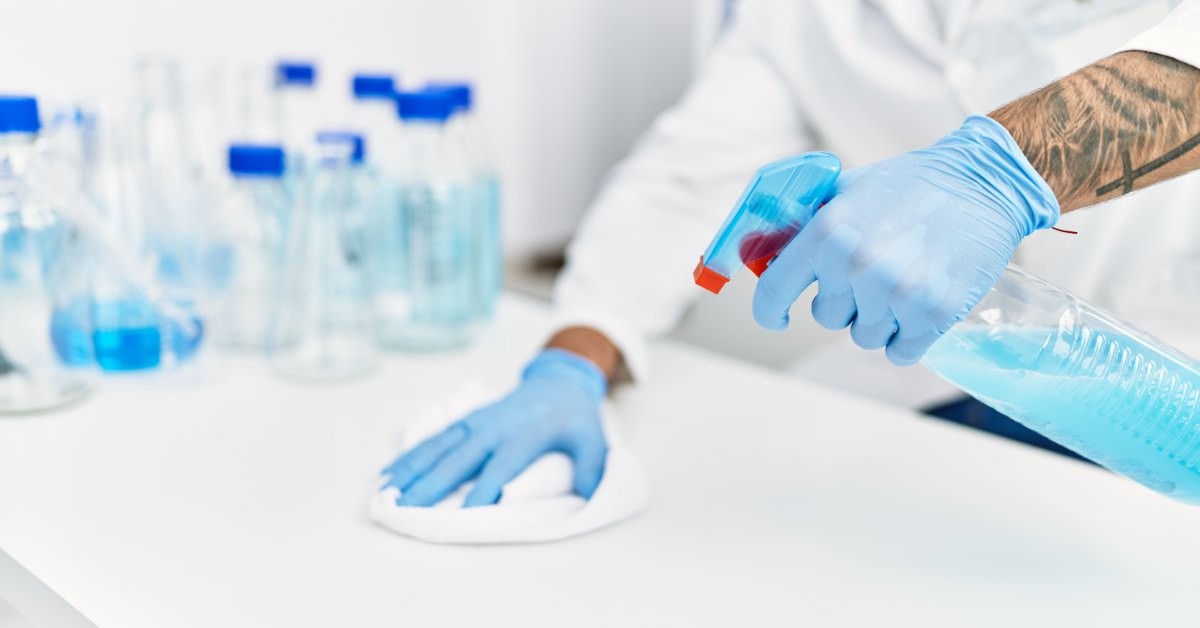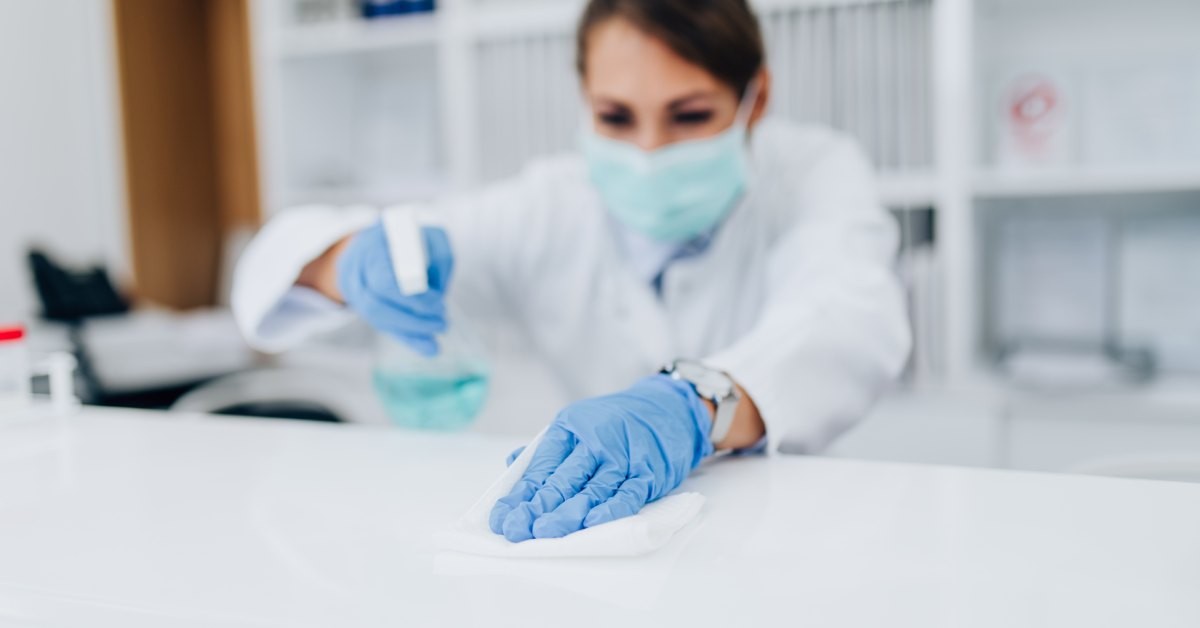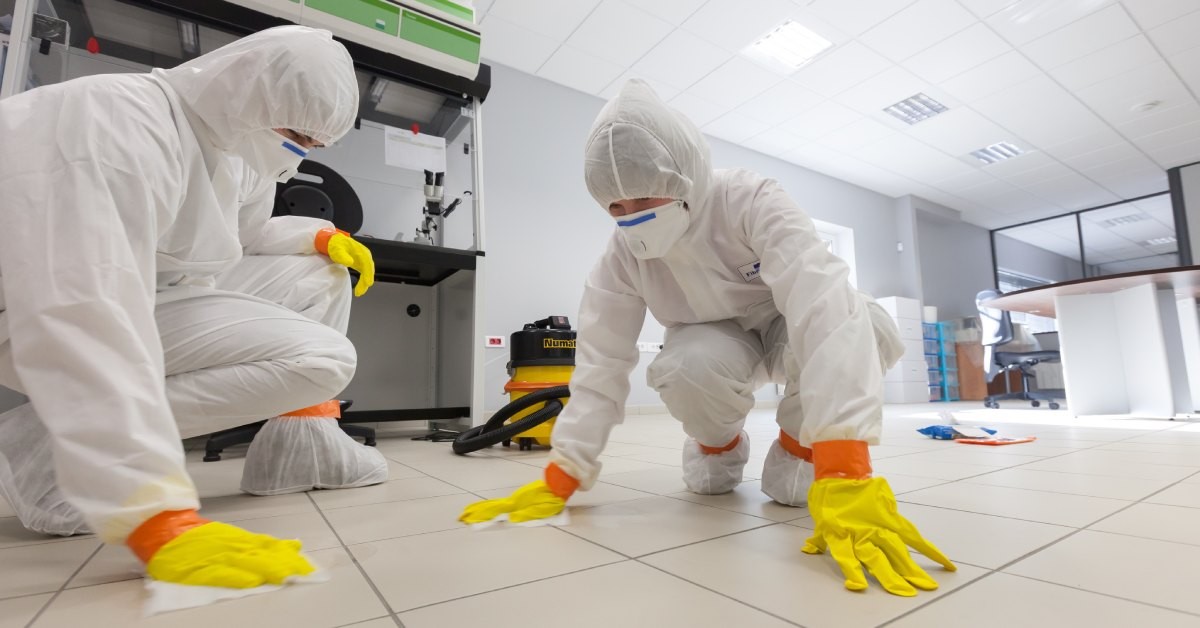Guide to Lab Disinfection: What You Should Know

A laboratory’s reliability hinges on its cleanliness, including contamination control. Whether in a research or medical setting, sterility serves as the backbone of effective work and accurate results. Beyond just appearances, a thoroughly disinfected workspace is vital in curbing the risks of cross-contamination, protecting the integrity of experiments, and safeguarding human lives.
Yet lab disinfection and bio-decontamination are frequently riddled with challenges stemming from misconceptions or improper practices.
This guide unpacks what you should know about lab disinfection, providing lab managers with actionable insights to ensure their labs remain bastions of safety and productivity. From identifying common pitfalls to introducing advanced technologies and regulatory frameworks, every section focuses on fostering a deeper understanding of what it takes to maintain an impeccably disinfected lab.
Find out how you can make your lab a safer place today.
Decoding Sterilization, Disinfection, and Sanitization
For any laboratory manager, understanding the distinction between sterilization, disinfection, and sanitization is fundamental. These terms represent varying levels of contamination control, each designed for specific purposes. Sterilization stands as the gold standard, eliminating all microbial life, including highly resistant bacterial spores. It’s a process typically associated with autoclaving or advanced hydrogen peroxide vapor systems, ideal when absolute sterility is non-negotiable.
Disinfection, on the other hand, destroys pathogens and other micro-organisms, and its efficacy against varying pathogens depends on which disinfectant is employed. It’s the go-to for daily upkeep and includes a variety of methods, ranging from chemical sprays or wipes that target high-risk surfaces to fumigation methods for whole-room bio-decontamination.
Sanitization, the least intensive of the three, focuses on reducing microbial loads to safe levels. For labs where precision meets high stakes, understanding when to employ each method can vastly improve contamination control procedures.
Missteps That Can Jeopardize Lab Safety
One of the most concerning aspects of lab disinfection lies in the prevalence of avoidable mistakes. Choosing the wrong disinfectant for specific microbial threats is a substantial error that you must avoid every time you’re in the lab.
- Efficacy and Dwell Time: Disinfectants are not universally effective, and using one that fails to target certain bacteria or viruses can leave the lab vulnerable. Additionally, improper dwell times—where a disinfectant is wiped off before adequately killing pathogens—negate its effectiveness.
- Surface Coverage: High-touch areas such as doorknobs, tabletops, and shared laboratory equipment are easy areas to overlook, presenting hotspots for contamination.
- Safety: Neglecting personal protective equipment (PPE) or failing to monitor an enclosure for vapor migration leaks can lead to unintended exposure to harmful chemicals. Addressing these missteps requires a diligent approach that combines precise application with adherence to established protocols.

Laying the Foundation for Effective Lab Disinfection
For a lab to remain consistently clean (contaminant-free) and compliant, every disinfection process must follow a structured approach. Begin by meticulously removing dirt and organic matter from surfaces, as these can create barriers that prevent disinfectants from working effectively. Identifying the specific microbial threats within the lab determines the choice of disinfectant and application method, ensuring targeted action.
Consistency is key. Establishing a routine disinfection schedule tailored to the lab’s level of activity and exposure risks minimizes gaps in cleanliness (contamination control). Equally important is communication. All lab personnel must be thoroughly trained in disinfection protocols to avoid discrepancies in execution. A cohesive strategy not only mitigates risks of contamination within workspaces but also creates a culture of diligence that permeates the lab's operations.
Choosing the Right Disinfectants for Optimal Results
Not all disinfectants are equally effective, so choose your solution wisely. The effectiveness of a given disinfectant depends on its chemical composition, delivery method, and application in specific laboratory contexts.
Quaternary ammonium compounds are frequently used for general disinfection, offering an effective (yet residue-prone) solution against many bacteria, viruses, and fungi. However, labs working with spore-forming bacteria often turn to sporicidal agents, hydrogen peroxide formulations, or peracetic acid to achieve comprehensive decontamination.
Concentration levels also play a pivotal role—too diluted, and the disinfectant becomes ineffective; too concentrated, and it may pose safety risks to personnel or damage sensitive equipment. Understanding dwell times and compatibility with laboratory materials ensures optimal action without compromising the integrity of the lab environment.
The Role of Cutting-Edge Technologies in Modern Disinfection
Innovations in disinfection technologies are reshaping how laboratories maintain cleanliness (contamination control). Automated aerosol, vapor, and hybrid systems, for instance, disperse disinfectants in fine particulate forms, helping to ensure uniform surface coverage even in hard-to-reach spots.
These technologies not only improve efficiency but also provide enhanced safety by minimizing direct human contact with potentially harmful chemicals. Leveraging these advancements equips laboratories with tools capable of meeting modern sterilization demands head-on.
You can equip your lab with today’s cutting-edge technology by using decontamination cleaning services to keep your workspace safe to use. Equipping yourself with the right materials and working with reputable experts will help you maintain a responsible lab environment.

Adhering to Regulatory Standards and Best Practices
Laboratory disinfection is not merely a matter of preference—it is tightly regulated by governing bodies to support safety and compliance. The Environmental Protection Agency (EPA), United States Pharmacopeia (USP), and European Union Medical Device Regulation Annex I provide robust frameworks for disinfection practices tailored to different laboratory environments.
Staying updated with these regulations is vital for lab managers aiming to implement best practices. Recordkeeping, such as that provided by CURIS Biodecontamination Services, serves as an essential aspect of regulatory compliance, enabling traceability for disinfectant usage and application frequency. Regular audits, both internal and external, further validate a lab’s adherence to established guidelines, fostering trust among team members and stakeholders alike.
Following a guide to lab disinfection and uncovering what you should know are only the initial steps in following the right standards—implement these practices every day to ensure consistent cleanliness.
Sustaining a Safe and Sterile Lab Culture
Lab disinfection is more than just a process; it’s a commitment to safety, accuracy, and excellence. By diligently addressing surface contamination, leveraging effective disinfectants, and incorporating state-of-the-art technologies, labs can elevate their operational standards to new heights. Beyond compliance, prioritizing cleanliness and contamination control cultivates an environment where scientific exploration and medical breakthroughs thrive.
Lab managers are instrumental in driving this commitment forward, serving as champions of sterility across their teams. Becoming vigilant about updates in disinfection technology and regulatory frameworks ensures continuous improvement. A safer, cleaner, contaminant-free lab starts with informed decisions, and it is with these decisions that innovation truly takes flight.